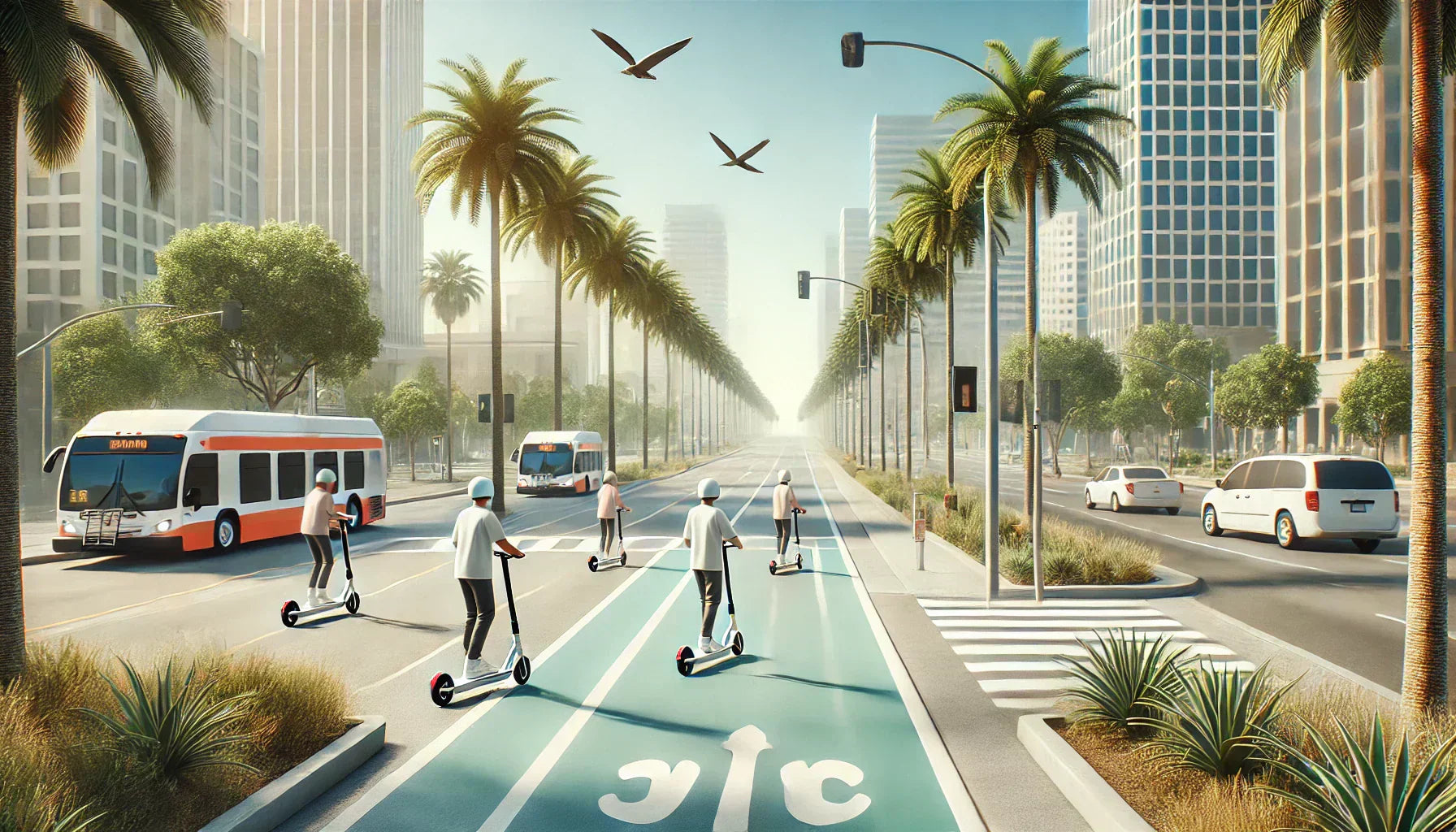California is home to some of the busiest urban centers and scenic roads, making it a prime location for electric scooters. Whether you're commuting in the city or exploring the coastline, understanding California's electric scooter laws is essential for ensuring a safe and legal ride. This guide provides an in-depth look at the state's electric scooter regulations, as well as city-specific rules that every rider should be aware of.
1. Statewide Regulations for Electric Scooters
Electric scooter usage is regulated under California’s Vehicle Code Section 21235, which outlines specific rules regarding where and how these scooters can be operated. Here’s what you need to know:
- Age Requirement: Riders must be at least 16 years old to legally operate an electric scooter.
- Helmet Requirement: Helmets are required for all riders under the age of 18. Riders over 18 are encouraged to wear helmets but are not legally required to do so.
- Sidewalk Riding: Riding on sidewalks is strictly prohibited. Electric scooters must be operated on roads or bike lanes.
- License Requirement: Riders must hold a valid driver’s license or learner’s permit to operate an electric scooter.
- Parking Regulations: Scooters must be parked in areas that do not block pedestrian walkways or building entrances.
2. Where You Can Ride an Electric Scooter in California
In California, electric scooters are allowed on roads with a speed limit of 25 mph or less and in bike lanes. On roads with higher speed limits, scooters are only permitted in bike lanes. Riders should be aware of the following guidelines:
- Bike Lanes: Scooters are encouraged to be ridden in bike lanes wherever available.
- Roads Without Bike Lanes: If a road doesn’t have a bike lane, you can ride an electric scooter on the far right side of the road
3. Electric Scooters in Major California Cities
While the state sets the framework for scooter use, local municipalities can impose additional regulations. Here's an overview of how electric scooter laws play out in some of California’s largest cities:
Los Angeles
Los Angeles has embraced electric scooters, but the city has a few rules to keep in mind:
- Scooter Zones: Electric scooters are allowed on most roads and bike lanes, but riding on sidewalks is prohibited.
- Parking Restrictions: LA has strict rules about where scooters can be parked. Riders must ensure scooters are not obstructing sidewalks, bus stops, or driveways. The city imposes fines on improperly parked scooters.
San Francisco
San Francisco regulates electric scooters through its Shared Mobility Permit Program, which has a few key rules:
- Designated Scooter Zones: Scooters are allowed in bike lanes and on roads. Riding on sidewalks is illegal.
- Scooter Sharing Programs: San Francisco regulates scooter-sharing programs closely. Only companies with permits from the San Francisco Municipal Transportation Agency (SFMTA) can operate.
San Diego
San Diego is another hotspot for electric scooter riders, but local laws have some unique restrictions:
- Restricted Areas: Scooters are prohibited in certain high-traffic areas, including Balboa Park and portions of Mission Beach.
- Sidewalk Prohibition: Riding on sidewalks is illegal across San Diego, with clear signage indicating where scooters are not permitted.
6. Final Thoughts
Electric scooters offer a convenient, environmentally-friendly way to navigate California’s streets, but staying informed about the rules is crucial for both safety and legal compliance. Always check local ordinances, as many cities have enacted additional regulations that may affect where and how you ride.
By adhering to California’s electric scooter laws, you can enjoy the benefits of riding while avoiding fines and penalties. As scooter technology evolves, so too will the laws, so be sure to stay updated on any changes.
Frequently Asked Questions
Is It legal To Carry A Passenger On An Electric Scooter In California?
No, carrying a passenger on an electric scooter in California is illegal. California electric scooter laws specify that scooters are designed for single riders only. Carrying a second person can affect balance and safety, increasing the risk of accidents. Riders must comply with this electric scooter California law.
Can You Carry Items While Riding An Electric Scooter In California?
Yes, you can carry items, but California electric scooter laws require that at least one hand remains on the handlebars at all times. Carrying large or bulky items that limit control is unsafe and may violate electric scooter California law. Use backpacks or secure storage options to transport items safely.
Are Electric Scooters Street-Legal In California?
Yes, electric scooters are street-legal in California. According to electric scooter laws California, scooters can be ridden on roads with speed limits under 25 mph and in bike lanes. Riders must follow standard traffic rules. Compliance with California electric scooter law ensures safe and legal operation in public areas.
Is It legal To Ride Electric Scooters On Sidewalks In California?
No, riding on sidewalks is prohibited under electric scooter laws California. This rule helps protect pedestrians. Instead, riders must use bike lanes or roads where permitted. Failing to follow this electric scooter California law can result in fines. Always stay aware of local signage and regulations for specific areas.
Is Wearing A Helmet While Riding An Electric Scooter In California Mandatory?
Yes, helmets are mandatory for riders under 18 per California electric scooter law. Adults 18 and older are not legally required to wear helmets, but it’s strongly recommended for safety. Following this electric scooter law California reduces the risk of head injuries during accidents and promotes responsible riding habits.
Do You Need Insurance Or Registration For Electric Scooters In California?
No, you don’t need insurance or registration for electric scooters in California. According to electric scooter laws in California, scooters are not classified like cars or motorcycles. However, riders must have a valid driver’s license or learner’s permit. Compliance with electric scooter law California ensures legal operation without unnecessary paperwork.
Do You Need A License Lo Ride An E-Scooter In California?
Yes, California electric scooter laws require riders to have a valid driver’s license or learner’s permit. This electric scooter California law helps ensure riders are familiar with basic traffic rules for safety, but riding without a license can result in fines. Always carry your license when using an e-scooter in California.
What Is The Minimum Age For E-Scooter Riders In California?
The minimum age to ride an e-scooter in California is 16. California electric scooter laws mandate that riders meet this age requirement and possess a valid driver’s license or learner’s permit. This electric scooter law California aims to ensure that riders have the necessary judgment and skills for safe operation.
What Are The Legal Requirements For Electric Scooters In California?
California electric scooter laws state that riders must be at least 16 years old, have a valid driver’s license or learner’s permit, and follow a 15 mph speed limit. Electric scooters must be used in bike lanes or on roads with speed limits under 25 mph. Helmets are required for riders under 18.
Can You Get A DUI Charge When Riding An E-Scooter In California?
Yes, you can get a DUI while riding an e-scooter in California. California electric scooter laws classify scooters as vehicles, meaning DUI laws apply. Riding under the influence of alcohol or drugs violates electric scooter law California, leading to fines, potential license suspension, and other legal consequences similar to car DUIs.






